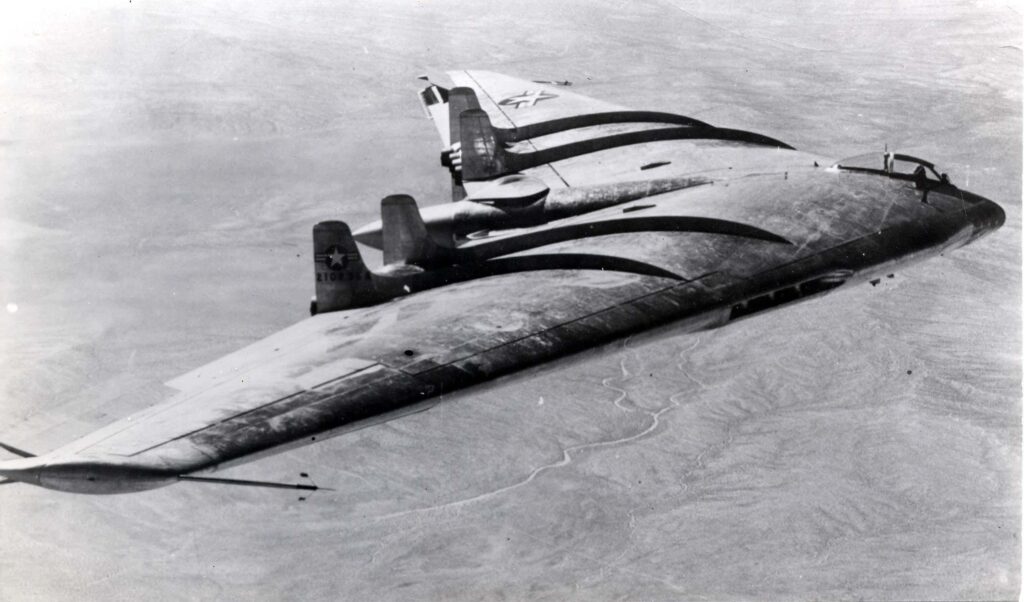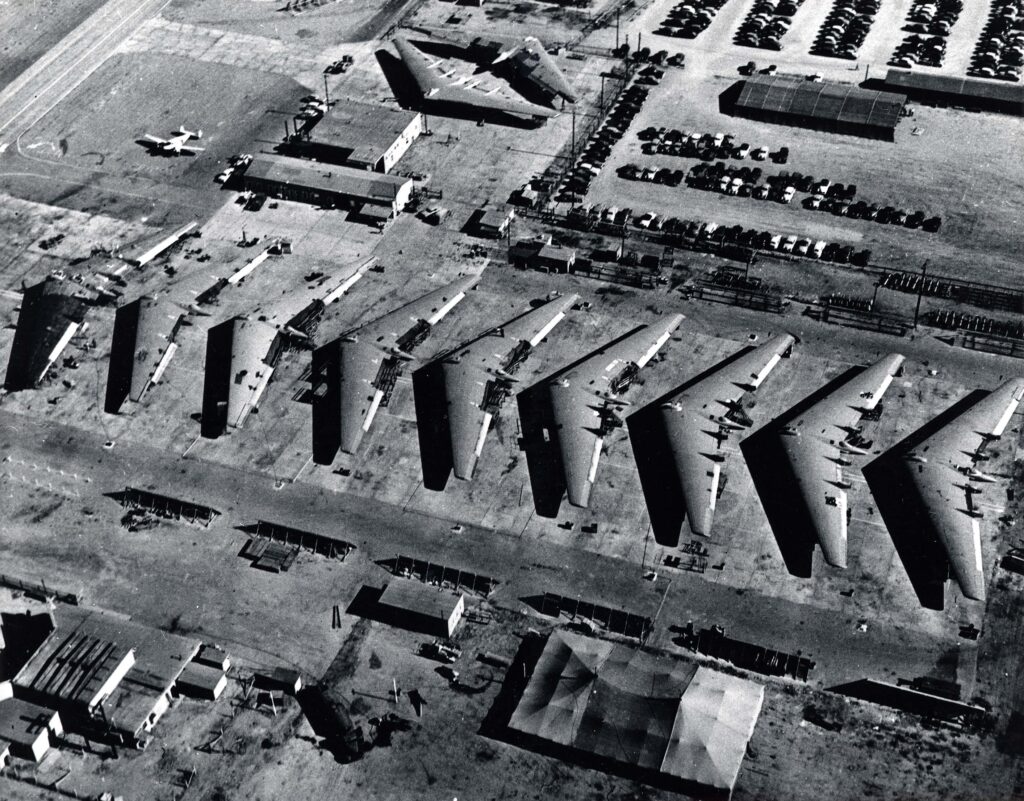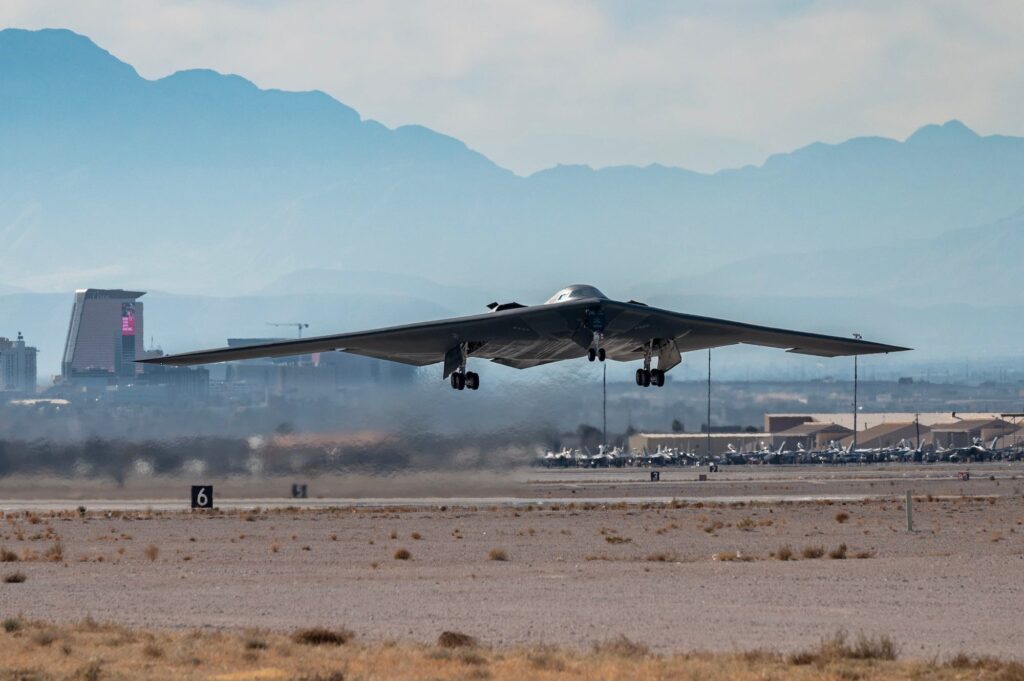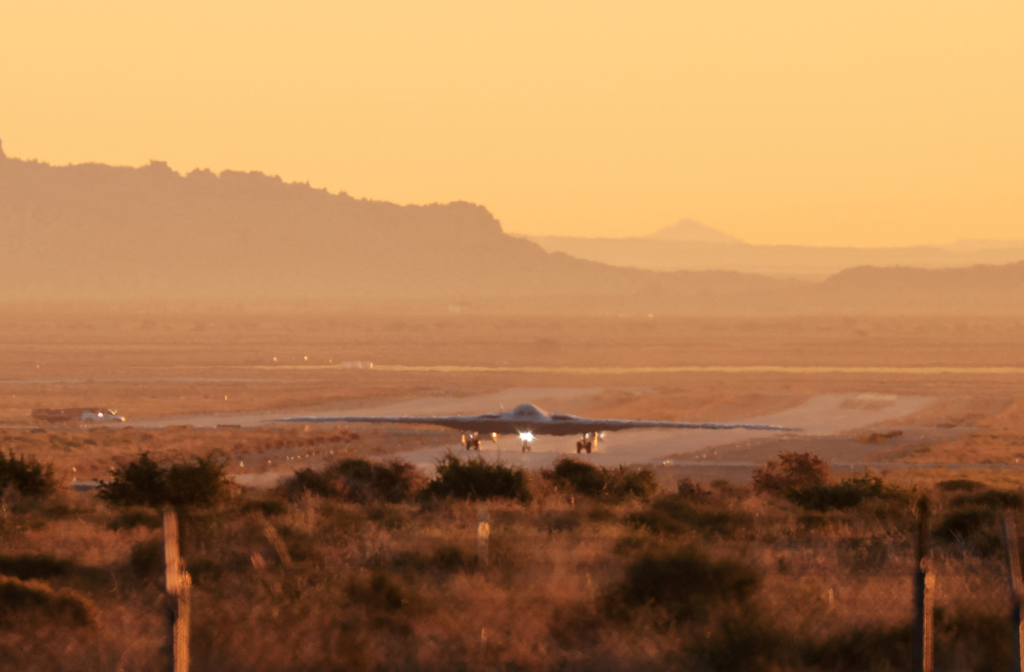- The B-21 bomber pairs cutting edge tech with a throwback aircraft design.
- It is based on a visionary aircraft design that dates back to World War II.
- That aircraft, the YB-49, minimized drag but proved too hard to fly with 1940s technology.
Described by Northrop Grumman as a sixth-generation bomber, the US Air Force's new B-21 Raider pairs the most modern stealth and targeting technology with what is actually a throwback-style design.
It is similar in appearance and mission to its direct predecessor, the B-2 Spirit, and demonstrates the ascendancy of the flying wing design for the most sophisticated bombers. But for all its space-age looks and capabilities, it is the product of advances in flight control technology based on a visionary aircraft design that dates to World War II.
Originally designed before America's entry into the Second World War, the YB-49 flying wing was intended to be America's first intercontinental bomber. Over the course of its development, however, it oddly proved to be both too advanced and too antiquated for its time.

The flying wing
The YB-49 was the final iteration of a flying wing bomber concept created by legendary aircraft designer Jack Northrop, founder of the Northrop Corporation.
The backdrop behind its development was stark. In 1941, concerned that an outright Nazi German victory in Europe would eliminate the ability to fly bombers from allied airbases in the continent, the United States Army Air Forces wanted a bomber capable of carrying about 10,000 pounds of ordnance at least 6,000 miles for round-trip intercontinental bombing runs in the event of war.
Most of the bombers at the time had ranges of around 2,000 miles and payloads ranging from 4,000 to 5,000 pounds. Consequently, engineering practices of the time would have likely called for a design that was up to three times larger than existing bombers.
But Northrop saw this as an opportunity to field a new kind of military aircraft; one that utilized the high-lift low-drag flying wing design.
The flying wing is designed to eliminate as much drag as possible. In conventional aircraft design, wings are needed for lift, but the tail structure, fuselage, and even the engines protrude outwards and create drag, reducing lift potential and thus engine efficiency.
Moreover, in a conventional design like the B-17, the bulk of the weight is centrally located in the fuselage, thus requiring heavier wings to support the weight. A flying wing, on the other hand, distributes weight over the span of the entire aircraft, meaning it can carry heavy loads while weighing less.
The concept was unorthodox. It had been proven possible by the British-made Dunne D.4 and D.5 models in 1908 and 1910 respectively, at the dawn of the age of flight, and Northrop himself built something of a prototype called the X-216H in 1929.
A larger test aircraft, the N-1M, was tested in July of 1940, proving the potential of the flying wing design. Northrop argued that because flying wings weighed less and were more aerodynamic, it could carry more bombs further, faster, and higher than conventional designs, and was the best way to build an intercontinental bomber.
Convinced by his prototypes, preliminary designs, and arguments, the US Army Air Forces contracted Northrop to develop such a heavy bomber in 1941.

Efficiency of structure and design
The first result of Northrop's efforts was the XB-35; a 172-ft wide and 53-ft long flying wing. The central focus of the aircraft was the emphasis on efficiency of structure and design.
The bomber's nine-man crew operated in a sealed section in the center of the aircraft that included a cockpit, equipment bay, crew cabin, and observation station. Eight bomb bays could carry some 10,0000 pounds of bombs, and the range was expected to amount to 7,500 miles.
The XB-35 was powered by eight piston engines driving contra-rotating propellers that were housed inside the wing. It also featured elevons — then a new type of control surface on the wing's trailing edge — to control pitch and roll and split ailerons on the wingtips to control yaw.
The bomber's small frontal area and profile also provided the added benefits of making it difficult for enemy fighters of the time to hit and for radar to detect.
But the bomber wasn't destined to serve in the war it was designed for. Delays caused by engineering difficulties and wartime priorities for the Northrop Corporation slowed development, and when Britain held, the need for a transcontinental bomber became less urgent.
In May 1944, the full production contract was canceled, but the USAAF allowed the continued development of the 13 pre-production XB-35s under construction for testing purposes. Two years later and with WWII over, the XB-35 conducted its first flight on June 25, 1946.
Though 13 aircraft were built, the program was beset by problems. The contra-rotating propellers proved so troublesome that they were eventually replaced by single prop engines. But this change drastically reduced performance, so much so that it was decided to scrap the propellers entirely in favor of the emerging technology of jet propulsion.
Two of the XB-35s were fitted with eight jet engines and were redesignated as YB-49s. First flown on October 21, 1947, the jet engines improved performance but came at a cost; two bomb bays had to be converted to house fuel tanks, and the added weight decreased the bomber's range and payload by more than half.
The YB-49 also proved to have problems with excessive yawing, as movements that shift the aircraft's nose to the side are known, limiting its ability to accurately deliver bombs. And although nuclear bombs didn't require high degrees of accuracy, the YB-49, designed in the days before knowledge of the atomic bomb was common, was unable to carry them.
On June 5, 1948, one day after the delivery of the first YB-49 to the Air Force, a flight test ended in catastrophic failure when the bomber broke apart midair and crashed, killing all five of the crew. The Air Force blamed structural and mechanical failures, while Northrop claimed the pilots had pushed the aircraft beyond its limits.
The following September, the Air Force changed the role of the YB-49 to reconnaissance, with a new intended designation of YRB-49. However, just four months later, the project was canceled due to budget cuts.
Northrop was allowed to continue testing the sole remaining YB-49, but on March 15, 1950, it was destroyed when its landing gear collapsed during a high-speed taxi run test.

The Spirit and the Raider
As the Air Force had decided against converting the remaining 11 XB-35 airframes in November of 1949, the flying wing concept was completely dead. With the aircraft originally drawn up in 1941 and planned for propellers, the technology just did not yet exist for it to fly the way it was intended.
It was both too advanced and too antiquated for its time.
The shuttering of the program was particularly hard on Jack Northrop, who had personally invested so much in the flying wing. In 1952, he sold his holdings in his company and retired.
Decades later, however, he would be vindicated. In 1979, the US Air Force initiated the Advanced Technology Bomber (ATB) program, which called for a new long-range strategic bomber with stealth features to evade enemy air defenses.
Remembering that the YB-49 proved difficult to detect, Northrop Corporation looked into the flying wing. The problems with aerial instability could now be solved by computers utilizing fly-by-wire technology and differential thrust, and so a flying wing design was submitted.
In April 1980, as a tribute to its founder, the company obtained permission from the Air Force to show the 85-year-old Northrop the new design. Northrop reportedly broke into tears when he saw the design and stated, "Now I know why God has kept me alive for the last 25 years."
In 1981, the Air Force selected Northrop's design as the winner of the ATB program. In 1997, the stealth bomber was officially introduced into service as the B-2 Spirit.
The B-2 has since conducted bombing operations in the former Yugoslavia, Iraq, Afghanistan, and Libya, and holds the record for the longest combat bombing operation in history. They remain some of the most potent weapons in the US inventory, and their deployments are almost always meant to convey American strength and resolve.
As advanced as the B-2s are, the cost to produce and maintain them have proven to be a limiting factor — so much so that the original order for 132 Spirits was reduced to just 21. In order to maintain a powerful bomber force and to keep up with technological innovation, the Air Force launched the Long Range Strike Bomber program in 2011.
The result is the B-21. Developed by Northrop Grumman, it is a completely updated aircraft meant to deal with contemporary and modern air defenses. Its design is also built on an open-system architecture concept, meaning it can be more easily armed and upgraded with weapons and systems that have yet to be invented.
At the unveiling of the B-21 in 2022, Secretary of Defense Lloyd Austin said that "the B-21's edge will last for decades to come."
The Air Force is planning to field at least 100 B-21s, with the first entering service in the mid-2020s via the initial low-rate production contract. They are expected to replace both the B-1 and B-2 bombers by the mid-2030s.
